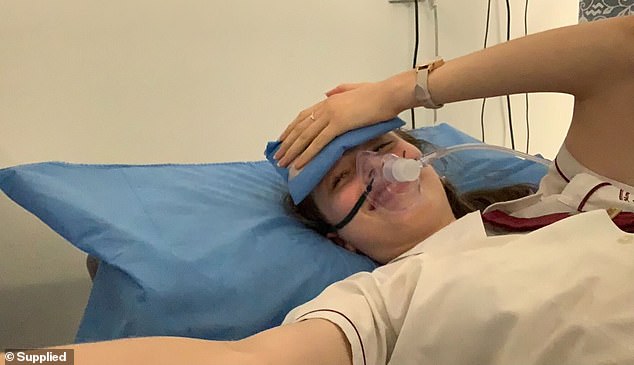I have suffered from debilitating migraines since I was just ten years old – I just want a normal life and for people to take me seriously
Ava Rebbechi says migraines stole her childhood. Now she is terrified that they will also steal her future.
Speaking to FEMAIL, the 20-year-old law student revealed she was only 10 when she first experienced the devastating effects of migraines.
“It was just after my tenth birthday. Every time it’s my birthday, I actually think of it as a birthday of my migraines, too,” she said.
Ava had been experiencing severe headaches for a few weeks before her first migraine, but doctors had warned her about the signs.
“I got that radiance, the spots in my vision and my heart sank. I thought, ‘This is really serious,’ she said.
Ava was just 10 when her migraines started – she’s pictured here around the time they started
She was having lunch at school with her friends and tried to read the back of a pack of snacks, only to find the spots that were blocking her view.
Next came the nausea and then the earth shattering pain.
“My parents took me straight to the doctor and it’s been a long journey since then,” she said.
Each time she switched doctors, they seemed optimistic that they could help her, but they came up with very few tangible results.
Ava’s migraines can last five days in a row. As a young girl she had them every week.

She believes migraines stole her childhood, and doesn’t want it to steal her future too

Ava is pictured here at her graduation. She smiles for the camera, but 30 minutes earlier she cried in pain and wondered how she would pass the milestone
The pain, nausea, fatigue and general feeling of being unwell led her to isolate herself.
She didn’t want to go to sleepovers in case she got migraines, and found that exercising made her more likely to have an episode.
“Being a young girl, I felt like no one really believed how bad it was or thought I was making it up,” she said.
Ava learned to endure the pain to some degree and quickly got over the symptoms, but it didn’t always stop an attack from leaving her in bed for days.
Sometimes she had to carefully consider whether to press ahead because she knew a worse attack was lurking.
“Sometimes it’s like, ‘Should I throw up and get rid of it or fight the nausea?'” she said.
‘I will never forget the night I graduated. There’s a shot of me smiling at the camera, trying my best not to ruin a good night. But half an hour before the recording was done, I was screaming in pain, in tears,” she said.

Ava is often at the doctors. Sometimes they give her oxygen to ease the pain
Ava eventually reached an age where she was allowed to try Botox to prevent her migraines and relieve her symptoms.
And it has worked – to a certain extent.
“I first got Botox in 2019. Now I only have migraines every two weeks, and most of them only last a day or two,” she said.
“That said, I just had one that lasted five days. I sometimes go to the hospital with those people, but they just try to give me Panadol, or fluids if I’m dehydrated from vomiting.”
Unfortunately for Ava, her “migraine aura” stopped coming as she got older. This means she has no warning before the pain and nausea hit.
Ava is a law student, in her third year, and hopes to one day pursue a career in law.
But her constant migraines make her worry about the future.

Ava is 11 years old, just a year later, and the migraines were already impacting her social life
“I’m driven, I want a career, but I’m also nervous,” she said.
She doesn’t know what type of employer would be willing to hire someone with chronic migraines, or what her career would look like.
“I should be transparent. I got a job in retail when I was 15 and didn’t tell them, and it was eating away at me. Especially when I had to call in sick,” she says.
She studies part-time at university and thinks that part-time work could be the solution.
“Ideally, it would be three or four days (a week), or five shorter days,” she said.
“I’ve learned to take it easy on myself. I’m known as the nap queen. I sit and watch television. And I try to stay hydrated and always have meds with me.”
Ava currently lives independently and doesn’t want to have to move back in with her parents or lose that if things get worse.
“I’d like to do things like get a dog — without worrying about whether I’ll be good enough to take care of him,” she said.
“This has been me for the past eleven years. I lost my youth. I felt like a guinea pig or a rat being poked and prodded to see if it worked.’
She said she feels like her migraines have ruined any family vacation or big event.
Her migraines often occur during her period, but not always.

She was always afraid she would ruin an event by getting sick – she was so isolated herself
Ava says her migraine symptoms have been dismissed by most people for years.
‘Only now, at the age of 20, do people take it seriously. My parents have always done that and are a great support,” she said.
She faced rumors at school when she missed classes or social gatherings. The fact that she was always underweight because migraines prevented her from eating and vomiting for days only made the situation worse.
‘It was unfair. All I thought was, ‘If you’re going to talk about me, talk about the real problem instead of making something up. That’s not fair service.’
Ever since her first migraine at age 10, Ava has feared the future. She hopes that one day she won’t have to be.
She’s sharing her story ahead of Migraine Awareness Week, which begins Sept. 4.
New research commissioned by Migraine & Headache Australia (a division of the Brain Foundation) shows that thousands of Australian women with migraines are leaving their workplace due to discrimination, stigma and lack of support.
This takes a huge toll on their mental health, career prospects and threatens progress in gender equality in the workplace.

As an adult she has tried to enjoy life more, but unfortunately the threat of migraines is always present. (She’s pictured here at a Harry Styles concert)
According to the research, most workplaces in Australia fail to support staff who suffer from migraines.
Almost three-quarters of people who suffer from migraines are women, and they are creating a significant barrier to achieving gender equality in the workplace. Women with migraines are often disbelieved and even bullied at work.
Many people are told they ‘make it up’ or are bullied about the condition at work, the study found, despite 4.9 million Australians suffering from the condition.
“Many Australians believe migraine is ‘just a bad headache’, and four in five managers don’t think migraine is reason enough to take time off from work,” said a Migraine and Headache Australia spokesperson.
Migraine sufferers are up to five times more likely to have poor mental health than those without migraines.

Ava weighs only 100 pounds and has faced the stigma of that. Most people don’t believe her migraines are the cause
While there is currently no cure for migraines, treatment can help people manage their condition.
Carl Cincinnato, director of Migraine & Headache Australia, stressed that changes are urgently needed to keep women with migraines in the labor market.
“I often hear from HR leaders: ‘If migraines are such a big problem, how come nobody complains about them?’ said Mr. Cincinnato.
‘Many people with migraine are forced to hide their symptoms because they fear discrimination and stigma. This has a huge impact not only on the lives of people with migraines, but also on workplace productivity, women’s participation in the labor market and the Australian economy,” he added.
“There are steps workplaces can take to support staff suffering from migraines, helping them better manage their condition.
“Unfortunately, the vast majority of workplaces do not take these steps and workplace migraines go almost entirely untreated.”
If you are experiencing migraine symptoms, it is important to see your doctor for a diagnosis and treatment plan.
Symptoms may include severe headache, nausea and vomiting, sensitivity to light, sensitivity to sound, visual disturbances such as an aura, sensitivity to smell and touch, as well as numbness of the face, hands, or feet.
Triggers can include stress, hormonal changes, dehydration, and lack of sleep.
